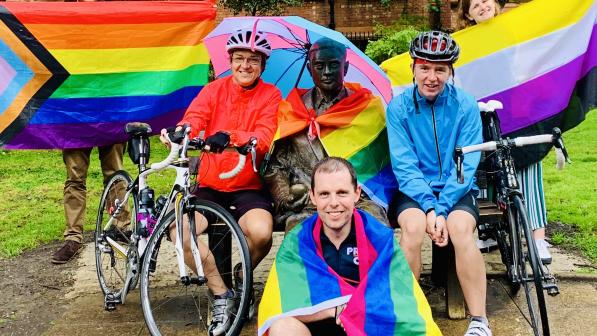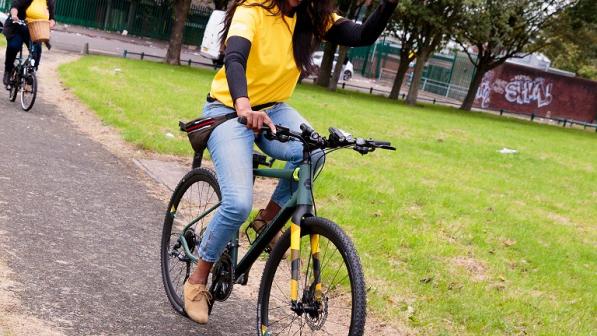How to make your cycling group more inclusive

What is inclusion?
We hear a lot about equality (or equity), diversity and inclusion (EDI). But what do these terms actually mean? According to Inclusive Employers, an organisation “trying to make inclusion an everyday reality”, diversity is about valuing who we are – how we identity ourselves as people, whether that is our nationality, culture, religion, ethnic origin, sexual orientation, beliefs or any other specific characteristic – and the differences between us.
In the context of EDI, equality is concerned with trying to make a fairer society so that everybody feels able to participate, while equity is about removing the barriers that prevent people from participating equally. Inclusion, on the other hand, could be defined as “the policy or practice of making sure that everyone in society has access to resources and opportunities”. In other words, it’s about everybody and how we make other people feel.
Why it matters
You might wonder why it’s important to be proactive when it comes to inclusion. Surely all groups are open and friendly and, as long as you have a roadworthy bike, you’ll be welcome to join, so why make a fuss about it? This is largely true but, nevertheless, many people can find it intimidating to join in with new activities or groups they are not familiar with, particularly when they don’t see people who look or sound like them.
Even with groups specifically catering to one of their ‘differences’ such as gender, sexual orientation or ability, they may feel they don’t belong because of another, separate difference such as age, religion, belief, or their ethnic or even linguistic and socio-economic background. This is known as ‘intersectionality’.

A brighter future
One of the best things about cycling is that it is an activity that almost everybody can enjoy. With more people cycling, it will become more mainstream and be more attractive to everybody. Groups that make an effort to be really inclusive are more interesting to ride with, retaining existing members and attracting new ones.
Steve Bateman, who is equity, diversity and inclusion officer for Cycling UK member group CTC Lancaster and South Lakes, says: “As a visually impaired tandem stoker, I am appreciative of all our members who ride the front of my tandems, which facilitates my sporting and social inclusion. Visually impaired people from all over the country struggle to find front riders so are facing increased social and sporting isolation and all that involves.”
We have a short, regular Tuesday morning ride to a named café which those who aren’t able to cycle to can get to by other means to enjoy the social aspects of the club
Steve Bateman, equity, diversity and inclusion officer, CTC Lancaster and South Lakes
He adds: “We also try to support our members who have conditions such as dementia, or are recently bereaved, by including them wherever practical. We have a short, regular Tuesday morning ride to a named café which those who aren’t able to cycle to can get to by other means to enjoy the social aspects of the club.”
The right thing to do
Ruby from Glasgow comments: “I like that the group I’m in isn’t a ‘women-only group’ but is ‘women led, all welcome, social and friendly pace’. It’s mainly women and non-binary people who come along, but men aren’t excluded. Usually it’s 90% women and the men there are respectful. It’s not all about who can go the fastest and so on.”
However, being more inclusive is not just about helping your group to be more sustainable, it’s also the right thing to do to bring about a fairer society.
Be kind
Above all, be kind. All of us, no matter what our external appearance might lead you to believe, can suffer from a hidden disability or a mental health issue such as anxiety or a lack of confidence, or be affected by major life events such as grief, illness or economic hardship.
Try not to judge others and give praise and thanks when they’re due – without being patronising – rather than criticism. If somebody’s behaviour or kit is not acceptable, try to give constructive pointers, rather than calling them out in front of others.
Alex Cuppleditch, head of volunteering and EDI lead at Cycling UK, says: “Inclusion is about being valued, heard, understood and accepted. The best way to achieve this is to interact, build positive relationships with each other and listen to each other’s experience and perspective without judgement.”
She adds: “Taking part in physical activity with other people in, for example, cycling groups can be a catalyst for change - sharing a passion breaks down barriers and gives us a connection that exceeds the superficial differences between us.”
Get involved
We will also be offering EDI training to our member groups in the near future so look out for that, and also see how we’re working in partnership with other organisations in the sustainable transport sphere to explore EDI further.




